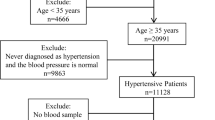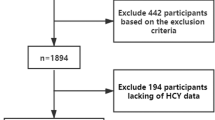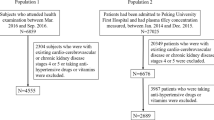Abstract
Background
Hyperhomocysteinemia (HHCY) is a risk factor for cardiovascular diseases (CVD). HHCY may interact with hypertension (HTEN) and an unfavorable cholesterol profile (UNFAVCHOL) to alter the risk of CVD.
Objectives
To estimate the prevalences of HHCY (1) isolated and (2) in combination with UNFAVCHOL and/or HTEN in different age categories. To provide information that may improve the screening and treatment of subjects at risk of CVD.
Design
Cross-sectional data on 12 541 men and 12 948 women aged 20+ y were used from nine European studies.
Results
The prevalence of isolated HHCY was 8.5% in subjects aged 20–40 y, 4.7% in subjects aged 40–60 y and 5.9% in subjects aged over 60 y. When combining all age groups, 5.3% had isolated HHCY and an additional 5.6% had HHCY in combination with HTEN and/or UNFAVCHOL. The combinations of risk factors increased with age and, except for HHCY&UNFAVCHOL, were more prevalent than predicted by chance. Of the young subjects (20–40 y), 24% suffered from one or more of the investigated CVD risk factors. This figure was 75.1% in the old subjects (60+ years).
Conclusions
A substantial number of subjects in selected European populations have HHCY (10.9%). In half of these cases, subjects suffer also from other CVD risk factors like UNFAVCHOL and HTEN. Older people in particular tend to have more than one risk factor. Healthcare professionals should be aware of this when screening and treating older people not only for the conventional CVD risk factors like UNFAVCHOL and HTEN but also HHCY, as this can easily be reduced through increased intake of folic acid via supplement or foods fortified with folic acid.
This is a preview of subscription content, access via your institution
Access options
Subscribe to this journal
Receive 12 print issues and online access
$259.00 per year
only $21.58 per issue
Buy this article
- Purchase on Springer Link
- Instant access to full article PDF
Prices may be subject to local taxes which are calculated during checkout


Similar content being viewed by others
References
Alfthan G, Pekkanen J, Jauhiainen M, Pitkaniemi J, Karvonen M, Tuomilehto J, Salonen JT & Ehnholm C (1994): Relation of serum homocysteine and lipoprotein(a) concentrations to atherosclerotic disease in a prospective finnish population based study. Atherosclerosis 106, 9–19.
Andersson A, Isaksson A & Hultberg B (1992): Homocysteine export from erythrocytes and its implication for plasma sampling. Clin. Chem. 38, 1311–1315.
Appel LJ, Moore TJ, Obarzanek E, Vollmer WM, Svetkey LP, Sacks FM, Bray GA, Vogt TM, Cutler JA, Windhauser MM, Lin PH & Karanja N (1997): A clinical trial of the effects of dietary patterns on blood pressure. DASH Collaborative Research Group. N. Engl. J. Med. 336, 1117–1124.
Araujo F, Lopes M, Goncalves L, Maciel MJ & Cunha-Ribeiro LM (2000): Hyperhomocysteinemia, MTHFR C677T genotype and low folate levels: a risk combination for acute coronary disease in a portuguese population [Letter]. Thromb. Haemost. 83, 517–518.
Arnesen E, Refsum H, Bonaa KH, Ueland PM, Forde OH & Nordrehaug JE (1995): Serum total homocysteine and coronary heart disease. Int. J. Epidemiol. 24, 704–709.
Ashfield-Watt PA, Whiting JM, Clark ZE, Moat SJ, Newcombe RG, Burr ML & McDowell IF (2003): A comparison of the effect of advice to eat either ‘5-a-day’ fruit and vegetables or folic acid-fortified foods on plasma folate and homocysteine. Eur. J. Clin. Nutr. 57, 316–323.
ATP III (2001): Executive summary of The Third Report of The National Cholesterol Education Program (NCEP) Expert Panel on Detection, Evaluation, and Treatment of High Blood Cholesterol In Adults (Adult Treatment Panel III). JAMA 285, 2486–2497.
Bates CJ, Mansoor MA, vanderPols J, Prentice A, Cole TJ & Finch S (1997): Plasma total homocysteine in a representative sample of 972 British men and women aged 65 and over. Eur. J. Clin. Nutr. 51, 691–697.
Brattstrom L, Lindgren A, Israelsson B, Andersson A & Hultberg B (1994): Homocysteine and cysteine: determinants of plasma levels in middle-aged and elderly subjects. J. Intern. Med. 236, 633–641.
Brouwer IA, Van Dusseldorp M, West CE, Meyboom S, Thomas CMG, Duran M, van het Hof KH, Eskes TKAB, Hautvast JGAJ, Steegers-Theunissen RPM, Hof KHV & Steegers Theunissen RPM (1999): Dietary folate from vegetables and citrus fruit decreases plasma homocysteine concentrations in humans in an dietary controlled trial. J. Nutr. 129, 1135–1139.
Clarke R & Armitage J (2000): Vitamin supplements and cardiovascular risk: review of the randomized trials of homocysteine-lowering vitamin supplements. Semin. Thromb. Hemost. 26, 341–348.
de Bree A, Verschuren WM & Blom HJ (2001a): Biological cardiovascular risk factors and plasma homocysteine levels in the general Dutch population. Atherosclerosis 154, 513–514.
de Bree A, Verschuren WMM, Blom HJ, De Graaf-Hess A, Trijbels FJM & Kromhout D (2001b): The homocysteine distribution: (mis)judging the burden. J. Clin. Epidemiol. 54, 462–469.
de Bree A, Verschuren WM, Kromhout D, mennen LI & Blom HJ (2002): Homocysteine and coronary heart disease: the importance of a distinction between low and high risk subjects. Int. J. Epidemiol. 31, 1268–1272.
de Lorgeril M, Salen P, Paillard F, Lacan P & Richard G (1999): Lipid-lowering drugs and homocysteine. Lancet 353, 209–210.
Dierkes J, Westphal S & Luley C (1999): Serum homocysteine increases after therapy with fenofibrate or bezafibrate. Lancet 354, 219–220.
Eliason SC, Ritter D, Chung HD & Creer M (1999): Interlaboratory variability for total homocysteine analysis in plasma. Clin. Chem. 45, 315–316.
European Atherosclerosis Society (1987): Strategies for the prevention of coronary heart disease: a policy statement of the European Atherosclerosis Society. Eur. Heart J. 8, 77–88.
Fokkema MR, Gilissen MF, van Doormaal JJ, Volmer M, Kema IP & Muskiet FA (2003): Fasting vs nonfasting plasma homocysteine concentrations for diagnosis of hyperhomocysteinemia. Clin. Chem. 49, 818–821.
Graham IM, Daly LE, Refsum HM, Robinson K, Brattstrom LE, Ueland PM, PalmaReis RJ, Boers GHJ, Sheahan RG, Israelsson B, Uiterwaal CS, Meleady R, McMaster D, Verhoef P, Witteman J, Rubba P, Bellet H, Wautrecht JC, deValk HW, Luis ACS, ParrotRoulaud FM, Tan KS, Higgins I, Garcon D, Medrano MJ, Candito M, Evans A E & Andria G (1997): Plasma homocysteine as a risk factor for vascular disease: The European Concerted Action Project. JAMA 277, 1775–1781.
Herrmann W, Quast S, Ullrich M, Schultze H, Bodis M & Geisel J (1999): Hyperhomocysteinemia in high-aged subjects: relation of B-vitamins, folic acid, renal function and the methylenetetrahydrofolate reductase mutation. Atherosclerosis 144, 91–101.
Hoogeveen EK, Kostense PJ, Jakobs C, Dekker JM, Nijpels G, Heine RJ, Bouter LM & Stehouwer CD (2000): Hyperhomocysteinemia increases risk of death, especially in type 2 diabetes: 5-year follow-up of the hoorn study. Circulation 101, 1506–1511.
Hu FB, Manson JE & Willett WC (2001): Types of dietary fat and risk of coronary heart disease: a critical review. J. Am. Coll. Nutr. 20, 5–19.
Johansson L, Drevon CA & Aa Bjorneboe GE (1996): The Norwegian diet during the last hundred years in relation to coronary heart disease. Eur. J. Clin. Nutr. 50, 277–283.
Kjeldsen SE, Erdine S, Farsang C, Sleight P & Mancia G (2002): 1999 WHO/ISH Hypertension Guidelines—highlights & ESH Update. J. Hypertens. 20, 153–155.
Klerk M, Verhoef P, Clarke R, Blom HJ, Kok FJ & Schouten EG (2002): MTHFR 677C → T polymorphism and risk of coronary heart disease: a meta- analysis. JAMA 288, 2023–2031.
Malinow MR, Axthelm MK, Meredith MJ, MacDonald NA & Upson BM (1994): Synthesis and transsulfuration of homocysteine in blood. J. Lab. Clin. Med. 123, 421–429.
Malinow MR, Bostom AG & Krauss RM (1999): Homocyst(e)Ine, diet, and cardiovascular diseases: a statement for healthcare professionals from the nutrition committee, American Heart Association. Circulation 99, 178–182.
Malinow MR, Ducimetiere P, Luc G, Evans AE, Arveiler D, Cambien F & Upson BM (1996): Plasma homocyst(e)Ine levels and graded risk for myocardial infarction: findings in two populations at contrasting risk for coronary heart disease. Atherosclerosis 126, 27–34.
mennen LI, de Courcy GP, Guilland JC, Ducros V, Bertrais S, Nicolas JP, Maurel M, Zarebska M, Favier A, Franchisseur C, Hercberg S & Galan P (2002): Homocysteine, cardiovascular disease risk factors, and habitual diet in the French Supplementation with Antioxidant Vitamins and Minerals Study. Am. J. Clin. Nutr. 76, 1279–1289.
Moller J, Christensen L & Rasmussen K (1997): An external quality assessment study on the analysis of methylmalonic acid and total homocysteine in plasma. Scand. J. Clin. Lab. Invest. 57, 613–619.
Moller J, Rasmussen K & Christensen L (1999): External quality assessment of methylmalonic acid and total homocysteine. Clin. Chem. 45, 1536–1542.
Netherlands Heart Foundation (2001): Homocysteine en hart- en vaatziekten [Homocysteine and cardiovascular disease]. The Hague: Netherlands Heart Foundation.
Nygard O, Vollset SE, Refsum H, Stensvold I, Tverdal A, Nordrehaug JE, Ueland M & Kvale G (1995): Total plasma homocysteine and cardiovascular risk profile. The Hordaland Homocysteine Study. JAMA 274, 1526–1533.
Pfeiffer CM, Huff DL, Smith SJ, Miller DT & Gunter EW (1999): Comparison of plasma total homocysteine measurements in 14 laboratories: an international study. Clin. Chem. 45, 1261–1268.
Refsum H, Fiskerstrand T, Guttormsen A B & Ueland PM (1997): Assessment of homocysteine status. J. Inherit. Met. Dis. 20, 286–294.
Riddell LJ, Chisholm A, Williams S & Mann JI (2000): Dietary strategies for lowering homocysteine concentrations. Am. J. Clin. Nutr. 71, 1448–1454.
Stanger O, Herrmann W, Pietrzik K, Fowler B, Geisel J, Dierkes J & Weger M (2003): DACH-LIGA homocystein (German, Austrian and Swiss Homocysteine Society): Consensus paper on the rational clinical use of homocysteine, folic acid and B-vitamins in cardiovascular and thrombotic diseases: guidelines and recommendations. Clin. Chem. Lab. Med. 41, 1392–1403.
Stehouwer CDA, Weijenberg MP, van den BM, Jakobs C, Feskens EJM & Kromhout D (1998): Serum homocysteine and risk of coronary heart disease and cerebrovascular disease in elderly men—a 10-year follow-up. Arteriol. Thromb. Vasc. Biol. 18, 1895–1901.
te Poele Pothoff MT, van den Berg M, Franken DG, Boers GH, Jakobs C, de Kroon IF, Eskes TK, Trijbels JM & Blom HJ (1995): Three different methods for the determination of total homocysteine in plasma. Ann. Clin. Biochem. 32, 218–220.
The Homocysteine Studies Collaboration (2002): Homocysteine and risk of ischemic heart disease and stroke: a meta- analysis. JAMA 288, 2015–2022.
Tripodi A, Chantarangkul V, Lombardi R, Lecchi A, Mannucci PM & Cattaneo M (2001): Multicenter study of homocysteine measurement—performance characteristics of different methods, influence of standards on interlaboratory agreement of results. Thromb. Haemost. 85, 291–295.
Ueland PM, Refsum H, Stabler SP, Malinow MR, Andersson A & Allen RH (1993): Total homocysteine in plasma or serum: methods and clinical applications. Clin. Chem. 39, 1764–1779.
van Oort FV, Melse-Boonstra A, Brouwer IA, Clarke R, West CE, Katan MB & Verhoef P (2003): Folic acid and reduction of plasma homocysteine concentrations in older adults: a dose–response study. Am. J. Clin. Nutr. 77, 1318–1323.
Verschuren WM, Jacobs DR, Bloemberg BP, Kromhout D, Menotti A, Aravanis C, Blackburn H, Buzina R, Dontas AS & Fidanza F (1995): Serum total cholesterol and long-term coronary heart disease mortality in different cultures. Twenty-five-year follow-up of the seven countries study. JAMA 274, 131–136.
Verschuren WMM, van Leer EM, Blokstra A, Seidell JC, Smit HA, Bueno de Mesquita HB, Obermann-de Boer GL & Kromhout D (1993): Cardiovascular disease risk factors in The Netherlands. Neth. J. Cardiol. 6, 205–210.
Vollset SE, Refsum H, Tverdal A, Nygard O, Nordrehaug JE, Tell GS & Ueland PM (2001): Plasma total homocysteine and cardiovascular and noncardiovascular mortality: the Hordalans Homocysteine Study. Am. J. Clin. Nut. 74, 130–136.
Wald DS, Law M & Morris JK (2002): Homocysteine and cardiovascular disease: evidence on causality from a meta-analysis. BMJ 325, 1202.
Werstuck GH, Lentz SR, Dayal S, Hossain GS, Sood SK, Shi YY, Zhou J, Maeda N, Krisans SK, Malinow MR & Austin RC (2001): Homocysteine-induced endoplasmic reticulum stress causes dysregulation of the cholesterol and triglyceride biosynthetic pathways. J. Clin. Invest. 107, 1263–1273.
Westphal S, Dierkes J & Luley C (2001): Effects of fenofibrate and gemfibrozil on plasma homocysteine. Lancet 358, 39–40.
Working Group on Risk and High Blood Pressure (1985): An epidemiological approach to describing risk associated with blood pressure levels. Final Report of the Working Group on Risk and High Blood Pressure. Hypertension 7, 641–651.
Author information
Authors and Affiliations
Corresponding author
Additional information
Guarantor: A de Bree.
Contributors: AdB and NMJvdP were responsible for the study concept. AdB collected the data, performed the statistical analyses, and wrote the article. All contributors were responsible for critical revision of the manuscript and delivered important input for the content.
Rights and permissions
About this article
Cite this article
de Bree, A., van der Put, N., Mennen, L. et al. Prevalences of hyperhomocysteinemia, unfavorable cholesterol profile and hypertension in European populations. Eur J Clin Nutr 59, 480–488 (2005). https://doi.org/10.1038/sj.ejcn.1602097
Received:
Revised:
Accepted:
Published:
Issue Date:
DOI: https://doi.org/10.1038/sj.ejcn.1602097
Keywords
This article is cited by
-
Hyperhomocysteinemia and its relations to conventional risk factors for cardiovascular diseases in adult Nigerians: the REMAH study
BMC Cardiovascular Disorders (2021)
-
Vitamin B12 intake and related biomarkers: Associations in a Dutch elderly population
The journal of nutrition, health & aging (2017)
-
Hyperhomocysteinemia independently associated with the risk of hypertension: a cross-sectional study from rural China
Journal of Human Hypertension (2016)
-
Effects of mild hyperhomocysteinemia on electron transport chain complexes, oxidative stress, and protein expression in rat cardiac mitochondria
Molecular and Cellular Biochemistry (2016)
-
Arterial stiffness is not associated with bone parameters in an elderly hyperhomocysteinemic population
Journal of Bone and Mineral Metabolism (2016)



